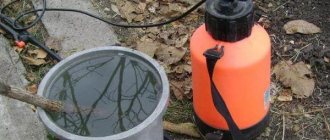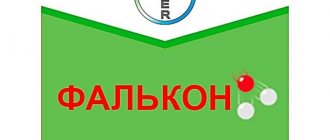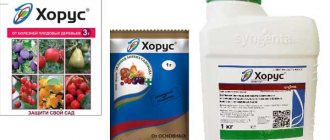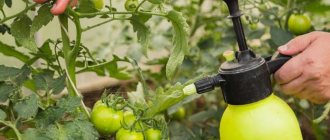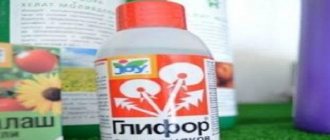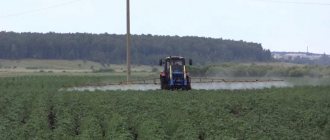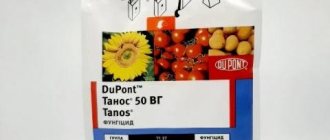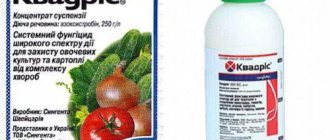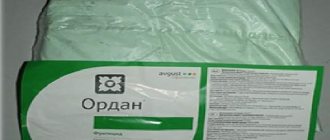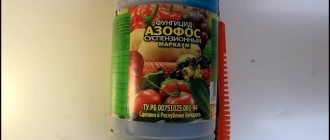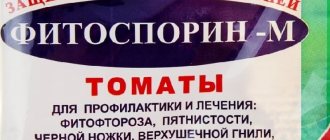Fungal infections are neither news nor wonder for gardeners. For what reasons it appears and why it affects all cultivated plants, including trees and shrubs, is not yet clear. Incorrect selection of dosage forms, namely fungicides, leads to complete or partial destruction of the crop.
All the farmer’s work goes down the drain. But by using the fungicide Skor, fruit loss can be avoided. The instructions for use will help solve problems during processing, and will also accurately indicate all the possible nuances of safety, spraying and preparation of the working solution.
Content
- Purpose and application
- Composition and dosage form
- Mechanism of action
- Regulations for the use of fungicide "SKOR, CE"
- Compatibility and analogues of "SKOR, CE"
- Restrictions and security
- Advantages of using the fungicide "SKOR, KE"
Fungicide "SKOR" is one of the best in terms of its effect on phytopathogens. Provides unsurpassed protection against smut and root rot, powdery mildew and scab of pome fruits and a number of diseases of stone fruit crops. The material includes the purpose, composition, regulations for use, processing features, limitations, compatibility, analogues, etc.
Examples of plant diseases caused by fungal infection
Positive and negative points
Skor is a systemic drug. And, despite the fact that it was created by leading Swiss specialists, it has pros and cons in use. There are more positive qualities. But you shouldn’t forget about the negative sides either.
In addition to the fact that Skor is designed to protect plants from fungal diseases and more, the advantages include:
- does not cause addiction for a long time if used in accordance with the instructions (carry out alternately with other fungicides);
- use up to 5-6 years in a row. Then a break for 12-14 months;
- not able to oxidize in open air;
- after spraying and action, the components decompose into simple substances that do not pose a threat to the soil and crops;
- can be combined with some certified insecticidal products;
- preventative and medicinal. Makes it possible to process seed material;
- promotes increased flowering, bud formation and yield;
- is able to give good results already at 14 degrees plus;
- prevents disputes from forming and developing;
- useful and harmless for young mycelium.
But the main advantage is that after processing the crops, there is no accumulation of harmful substances in the grown crop.
There are significantly fewer negative aspects of using Skor. But there is one thing why summer residents don’t like it. The fact is that when the temperature increases (from +25), the solution of the drug for plants will not be beneficial.
The fungicide is useless in the presence of downy mildew. Just like most drugs of this class, it is not recommended during flowering and ovary formation.
Purpose and application
The drug "SKOR, KE" is widely used in agricultural production and private farms for processing the following crops.
Table 1 Purpose of the fungicide "SKOR, KE"
| Processed crop | Harmful object |
| Grape | Oidium (powdery mildew), black spot, rubella, black rot |
| Root vegetables (potatoes, carrots, sugar beets) | Alternaria blight, cercospora blight |
| Stone fruits (peach, apricot, plum, cherry, sweet cherry) | Clusterosporiosis, leaf curl, coccomycosis |
| Open ground tomato | Alternaria leaf blight on stems and fruits |
| Pome crops (apple, pear) | Alternaria, scab, powdery mildew |
| Ornamental crops | Powdery mildew |
| Rose | Spotting |
| Flower crops | Powdery mildew, gray mold |
Grape oidium, external signs of berry damage
In what cases is this fungicide used?
The systemic fungicide Skor in private farms can be used to protect the garden: trees and shrubs (from Alternaria, scab, leaf curl, powdery mildew, clasterosporia), grapevines (from oidium, black rot), as well as vegetables, root crops (carrots, tomatoes and potatoes - from Alternaria blight) and flowers from a number of diseases. It keeps the green mass intact until autumn, resulting in no reduction in yield.
In addition, the drug Skor has a stimulating effect on the buds of fruit trees; on the treated plants, increased formation of fruit branches occurs, which has a beneficial effect on the harvest of the next season.
Mechanism of action
"SKOR, CE" is a systemic fungicide with preventive, therapeutic and immunizing effects.
Difenoconazole, penetrating into plant tissue and spreading through its vegetative parts, completely blocks the growth of pathogenic mycelium and significantly reduces the level of sporulation. Absorption of the active substance occurs gradually, which ensures the fungicidal stability of the drug for a long time.
The drug has a therapeutic effect and is actively used during illness. But the best results come from its preventive use.
The period of protective action is 7-21 days.
The speed of initial exposure is 2-3 hours after treatment.
Examples of manufactured drugs "SKOR, CE"
Regulations for the use of fungicide "SKOR, CE"
Treatment is carried out by spraying using any ground spraying systems or hand sprayers. Airborne processing is prohibited.
The maximum number of treatments is no more than 4 times. As a rule, 1-2 times before flowering and 1-2 times after flowering of fruit and berry crops. The last treatment is carried out no later than 3 weeks before harvest.
Table 2 Regulations for the use of the fungicide "SKOR, KE"
| Culture | Dosage | Consumption rate | Number of treatments | Waiting period | Features of treatments |
| Grape | 0.3–0.4 l./ha (3-4 ml/10 l. water) | 10 l/100 m² | 4 | 10 | The first treatment is in the spring in the budding-flowering phase, the second is before the berries close in the bunch, then after 14 days |
| Open ground tomato and root vegetables (potatoes, carrots) | 0.3–0.5 l./ha (3-5 ml/10 l. water) | 2-4 l/100 m² | 2 | — 5 days for potatoes; — 10 days for carrots; — 7 days for tomatoes | The first treatment when the first signs of the disease are detected, the second after 14 days |
| Stone fruits (peach, apricot, plum, cherry, sweet cherry) | 0.2 l/ha (2 ml/10 l. water) | 10 l/100 m² or 2–5 l/tree depending on crown size | 2 | 21 | The first treatment is in the “green cone” phase, the second after flowering |
| Pome fruits (apple, pear) | 0.3–0.35 l/ha (3–3.5 ml/10 l. water) | 10 l/100 m² | 2 | 21 | Spraying during the growing season before and after. When treating scab and powdery mildew, the dosage can be halved, and the number of treatments increased up to 3 times. |
| Decorative and floral crops | 2-5 ml/10 l. water | 10 l/100 m² | 2-4 | No | Treatment begins when signs of disease are detected, repeated treatment is carried out after 14 days |
Instructions for use
Fungicide Skor is used to protect against mycilium parasitic fungi on fruit trees, shrubs, vegetables, and flowers. Plants are sprayed only with freshly prepared working substance. The fungicide is most effective in the initial stages of the disease.
It is recommended to carry out treatment in the morning or evening. To avoid spraying the solution onto other plants, the wind speed should not be more than 5 m per second. The last spraying should be carried out no later than 30 days before the start of harvest.
Compatibility and analogues of "SKOR, CE"
Compatible with most agrochemicals used for treating fruits, vegetables and grapevines. However, it is recommended to conduct a compatibility test and consult with specialists.
As part of tank mixtures, it is used together with insecticides to protect plants from insect pests.
Difenoconazole works both independently in mono preparations and in combination with mefenoxam, propiconazole and cyproconazole.
Table 3 Pesticides containing difenoconazole
| Area of use | Monotherapy drugs based on difenoconazole | Preparations containing, including difenoconazole |
| a) for agricultural production | “Diskor, CE”, “Rayok, CE”, “Rangoli-Cursor, CE”, “Skor, CE”, “Skoroshans, CE”, “Fardi, CE” | "Alcazar, KS", "Amistar Gold, SK", "Attik, KS", "Vintage, ME", "Diamond Super, KS", "DVD Chance, KS", "Dividend Star, KS", "Dividend Supreme, KS", "Dinali, DC", "Capella, ME", "Magnello, CE", "Maxim Plus, KS", "Medea, ME", "Oplot, VSK", "Rias, CE", "Revus Top, SK", "Celest Top, KS", "Serkadis Plus, KS", "Therapist Pro, KS", "Tsideli Top, DK", "Chansomethox Trio, KS", "Embrelia Extra, SK", "Embrelia, SK" and etc. |
| b) for private household plots | "Diskor, CE", "Planthenol, CE", "Rayok, CE", "Rangoli-Cursor, CE", "Skor, CE", "Keeper, CE", "Pure Flower, CE" | "Medea, ME" |
Compatibility of Skor with other drugs
What can you mix “Skor” with in the tank mixture? The combination of this drug with insecticides, acaricides, pesticides and other fungicides is allowed. This feature allows you to significantly reduce the number of necessary treatments during the season.
If you have any doubts about the compatibility of the fungicide "Skor" with an insecticide or pesticide, you should carefully read the instructions for use.
Expert opinion
Oksana Alexandrovna
A gardener with extensive experience. Vegetable gardening is more than just a hobby for me.
It is prohibited to combine this drug with chemicals that have an alkaline reaction.
The combination of “Scora with adhesives” in a tank mixture is possible, but there is no urgent need for this, since the working solution already lingers on the leaves in sufficient volume.
Restrictions and security
a) Warm-blooded . Hazard class for humans - class 3. The drug is low-toxic and does not irritate the skin and mucous membranes of the eyes. The exit time after treatment for manual work is 1 day, for mechanized work - 3 days, in private household plots - 3 days.
b) Bees, fish, etc. Hazard class for bees – class 3. The drug is safe for bees, non-toxic for birds, earthworms, and low toxic for fish.
c) Soil . Soil resistance class – 2nd class. Studies show that after 2 years of using the drug, residual amounts of the toxicant are not recorded already on the 3rd day.
d) Fruits . The waiting period before harvesting is from 7 to 21 days, depending on the crop. The content of the active substance during control measurements is 20-40% below the maximum permissible level, and when harvesting, residual quantities are not recorded at all. This clearly indicates the safety of the drug.
Advantages of using the fungicide "SKOR, KE"
- The drug does not inhibit plants, no phytotoxicity was detected.
- The action of the fungicide "SKOR, KE" is highly selective in relation to the plants on which it is applied.
- There is no resistance if the regulations for use are followed.
- Providing long-term protection (up to 3 weeks).
- Timely and competent use of the drug means obtaining a high-quality harvest with the specified consumer characteristics.
- Due to the long-term preservation of the photosynthetic properties of the surface of plant leaves that are not damaged by the disease, a significant increase in yield is ensured.
- From practice it has been determined that “SKOR, CE” is one of the most effective fungicides (from triazoles) for protecting pome and stone fruit crops from scab.
- The drug "SKOR, KE" is one of the five most used fungicides to protect grapes from common diseases. Provides the best protection of grapes from oidium (powdery mildew)
Release form, active substance and manufacturer
The drug is marketed in the form of an emulsion concentrate and is classified as a triazole. This is a systemic and contact fungicide, that is, it begins to act when it comes into contact with the vegetative mass of plants or seeds, and then penetrates with juices into all organs, destroying pathogens. Skora contains difenoconazole in an amount of 250 grams per liter.
The fungicide is produced by Syngenta AG, a Swiss company leading the production of products for plant and seed materials, with a large number of subsidiaries around the world.
